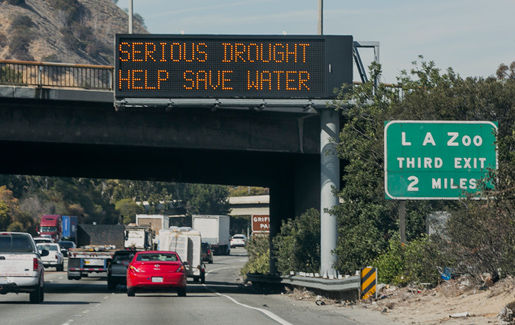
As drought-stricken California struggles to meet the mandatory water use restrictions Gov. Jerry Brown announced earlier this month, the governor is urging a sharp increase in fines for the worst violators, and moving to help local water agencies conduct environmental reviews more quickly.
On Apr. 28, Brown called for legislation to sharply increase fines up to a maximum $10,000 for the worst violations of the conservation orders. The current maximum fine is $500 per day.
Also under Brown’s proposal, wholesale and retail water agencies, as well as city and county governments, will be able to issue penalties. They could enforce both local water restrictions and restrictions ordered by the State Water Resources Control Board. Monetary penalties would go toward local conservation efforts.
In a separate action, Brown directed state agencies to help local water agencies cut the amount of time needed to comply with state-required environmental reviews.
The proposed new penalties come amid continuing debate about Brown’s unprecedented April 1 executive order mandating that over 3,000 urban water districts in the state cut their water use by an overall 25 percent this year compared with 2013. The order also directs the state to provide financial help to homeowners shifting to drought-resistant landscaping, and rebates for new water-efficient appliances.
The order focuses mainly on urban water uses like lawns, parks, public medians and golf courses, which take up less than a quarter of water use by people in the state.
“I would hope that we don’t see this in some punitive way, but that we see the challenge … the climate is getting warmer, the weather is getting more extreme and unpredictable, and we have to become more resilient, more efficient and more innovative,” the governor said then.
A major bone of contention is the omission from the April 1 order of any mandatory or voluntary conservation targets for agriculture, which uses nearly 80 percent of water not designated for environmental conservation. Instead, irrigation districts were told to develop drought management plans and monitor groundwater levels, and the State Water Resources Control Board was told to go after illegal and wasteful water users.
In exempting agriculture from cutbacks, Brown has sided with farmers who say they have already suffered four years of drought as well as sharp cutbacks by state and federal water providers, resulting in more land left fallow and lower income for the agriculture industry. Thousands of farm workers have also been put out of work.
Many water and conservation experts say agriculture should be included in the cutbacks. An often-cited issue is increasing pumping of groundwater, which in some Central Valley areas has already caused the land to sink measurably. Until 2014, California was the only western state not regulating groundwater withdrawals, and the new regulations don’t become fully effective until 2022.
Another issue is planting of highly profitable but water-guzzling crops like almonds. Many farmers also continue to use flood irrigation rather than the much more efficient drip irrigation.
Some environmentalists also call for limiting water use on land used to raise crops for animal feed.
The debate takes place against the background of an antiquated allocation system that gives priority, and lower rates, to holders of “senior” water rights – those claimed before California established a permit process in 1914 – with holders of “junior” rights claimed after that time receiving less.
Though California is the country’s largest agricultural producer and employs over 400,000 people, the industry accounts for just 2 percent of the state’s gross domestic product.
Meanwhile, cities facing the sharpest cutbacks are pleading for exemptions because they have invested in recycled or desalinated water, or face great demands for water during extreme summer temperatures, or rely on local sources rather than state resources.
Also sharply debated is the governor’s failure to include the oil and gas industry in his mandatory restrictions. Environmentalists estimate that more than two million gallons of fresh water are used daily to stimulate oil wells through hydraulic fracturing, or fracking, and related processes.
The oil industry contends that such drilling produces more water than oil, and much of that water is provided to farmers. But environmentalists also point out that earlier this year, California’s Division of Oil, Gas and Geothermal Resources required oil companies to shut down 12 wastewater wells in the Central Valley because they are located close enough to underground wells for drinking or agricultural water to threaten contamination. Another 176 wells are undergoing investigation, and over 2,500 more wells are in areas that were never approved for wastewater injection.
Zack Malitz of the social action organization CREDO told Reuters earlier this year, “Gov. Brown is forcing ordinary Californians to shoulder the burden of the drought by cutting their personal water use while giving the oil industry a continuing license to break the law and poison our water. Fracking and toxic injection wells may not be the largest users of water in California, but they are undoubtedly some of the stupidest.”
Photo: Damian Dovarganes/AP










